Ultrasound Characterization of Patellar Tendon in Non-Elite Sport Players with Painful Patellar Tendinopathy: Absolute Values or Relative Ratios? A Pilot Study
Abstract
1. Introduction
2. Methods
2.1. Participants
2.2. Pain and Related-Disability
2.3. Ultrasound Imaging of the Patellar Tendon
2.4. Neovascularization and Doppler Assessment of the Patellar Tendon
2.5. Statistical Analysis
3. Results
3.1. Association between Gross Ultrasound Measurements and Pain and Related-Disability
3.2. Between-Groups Ultrasound Measurements of the Patellar Tendon
3.3. Discriminant Validity of Ultrasound Measurement Ratios
3.4. Association between Ultrasound Ratios and Pain and Related-Disability
3.5. Clinical and Ultrasound Measurements by Neovascularization
4. Discussion
5. Conclusions
Supplementary Materials
Author Contributions
Funding
Conflicts of Interest
References
- Cook, J.L.; Purdam, C.R. Is tendon pathology a continuum? A pathology model to explain the clinical presentation of load-induced tendinopathy. Br. J. Sports Med. 2008, 43, 409–416. [Google Scholar] [CrossRef]
- Ramos, L.A.; De Carvalho, R.T.; Garms, E.; Navarro, M.S.; Abdalla, R.J.; Cohen, M. Prevalence of pain on palpation of the inferior pole of the patella among patients with complaints of knee pain. Clinics 2009, 64, 199–202. [Google Scholar] [CrossRef] [PubMed]
- Lian, O.B.; Engebretsen, L.; Bahr, R. Prevalence of jumper’s knee among elite athletes from different sports: A cross-sectional study. Am. J. Sports Med. 2005, 33, 561–567. [Google Scholar] [CrossRef] [PubMed]
- Docking, S.; Rio, E.; Cook, J.; Orchard, J.; Fortington, L.V. The prevalence of Achilles and patellar tendon injuries in Australian football players beyond a time-loss definition. Scand. J. Med. Sci. Sports 2018, 28, 2016–2022. [Google Scholar] [CrossRef] [PubMed]
- Zwerver, J.; Bredeweg, S.; Akker-Scheek, I.V.D. Prevalence of jumper’s knee among non-elite athletes from different sports; a cross-sectional survey. Br. J. Sports Med. 2011, 45, 324. [Google Scholar] [CrossRef]
- Wu, F.; Nerlich, M.; Docheva, D. Tendon injuries: Basic science and new repair proposals. EFORT Open Rev. 2017, 2, 332–342. [Google Scholar] [CrossRef]
- Järvinen, T.A. Neovascularisation in tendinopathy: From eradication to stabilisation? Br. J. Sports Med. 2019, 54, 1–2. [Google Scholar] [CrossRef]
- Cook, J.L.; Malliaras, P.; De Luca, J.; Ptasznik, R.; Morris, M.E.; Goldie, P. Neovascularization and pain in abnormal patellar tendons of active jumping athletes. Clin. J. Sport Med. 2004, 14, 296–299. [Google Scholar] [CrossRef]
- McAuliffe, S.; McCreesh, K.; Culloty, F.; Purtill, H.; O’Sullivan, K. Can ultrasound imaging predict the development of Achilles and patellar tendinopathy? A systematic review and meta-analysis. Br. J. Sports Med. 2016, 50, 1516–1523. [Google Scholar] [CrossRef]
- Rio, E.; Moseley, L.; Purdam, C.; Samiric, T.; Kidgell, D.; Pearce, A.J.; Jaberzadeh, S.; Cook, J. The Pain of Tendinopathy: Physiological or Pathophysiological? Sports Med. 2013, 44, 9–23. [Google Scholar] [CrossRef]
- Fazekas, M.L.; Sugimoto, D.; Cianci, A.; Minor, J.L.; Corrado, G.D.; D’Hemecourt, P.A. Ultrasound examination and patellar tendinopathy scores in asymptomatic college jumpers. Physician Sportsmed. 2018, 46, 477–484. [Google Scholar] [CrossRef] [PubMed]
- Gisslen, K.; Gyulai, C.; Söderman, K.; Alfredson, H. High prevalence of jumper’s knee and sonographic changes in Swedish elite junior volleyball players compared to matched controls. Br. J. Sports Med. 2005, 39, 298–301. [Google Scholar] [CrossRef] [PubMed]
- Cook, J.; Kiss, Z.S.; Khan, K.Μ.; Purdam, C.Ρ.; Webster, K.Ε. Anthropometry, physical performance, and ultrasound patellar tendon abnormality in elite junior basketball players: A cross-sectional study. Br. J. Sports Med. 2004, 38, 206–209. [Google Scholar] [CrossRef] [PubMed]
- Helland, C.; Bojsen-Møller, J.; Raastad, T.; Seynnes, O.R.; Moltubakk, M.M.; Jakobsen, V.; Visnes, H.; Bahr, R. Mechanical properties of the patellar tendon in elite volleyball players with and without patellar tendinopathy. Br. J. Sports Med. 2013, 47, 862–868. [Google Scholar] [CrossRef]
- Benítez-Martínez, J.C.; Valera-Garrido, F.; Martínez-Ramírez, P.; Ríos-Díaz, J.; Del Baño-Aledo, M.E.; Medina-Mirapeix, F. Lower Limb Dominance, Morphology, and Sonographic Abnormalities of the Patellar Tendon in Elite Basketball Players: A Cross-Sectional Study. J. Athl. Train. 2019, 54, 1280–1286. [Google Scholar] [CrossRef]
- Obst, S.J.; Heales, L.J.; Schrader, B.L.; Davis, S.A.; Dodd, K.A.; Holzberger, C.J.; Beavis, L.B.; Barrett, R. Are the Mechanical or Material Properties of the Achilles and Patellar Tendons Altered in Tendinopathy? A Systematic Review with Meta-analysis. Sports Med. 2018, 48, 2179–2198. [Google Scholar] [CrossRef]
- Slane, L.C.; Dandois, F.; Bogaerts, S.; Vandenneucker, H.; Scheys, L. Non-uniformity in the healthy patellar tendon is greater in males and similar in different age groups. J. Biomech. 2018, 80, 16–22. [Google Scholar] [CrossRef]
- Ağladıoğlu, K.; Akkaya, N.; Güngör, H.R.; Akkaya, S.; Ök, N.; Özçakar, L. Effects of Cigarette Smoking on Elastographic Strain Ratio Measurements of Patellar and Achilles Tendons. J. Ultrasound Med. 2016, 35, 2431–2438. [Google Scholar] [CrossRef]
- Rio, E.K.; Mc Auliffe, S.; Kuipers, I.; Girdwood, M.; Alfredson, H.; Bahr, R.; Cook, J.L.; Coombes, B.; Fu, S.N.; Grimaldi, A.; et al. ICON PART-T 2019–International Scientific Tendinopathy Symposium Consensus: Recommended standards for reporting participant characteristics in tendinopathy research (PART-T). Br. J. Sports Med. 2019, 54, 627–630. [Google Scholar] [CrossRef]
- Jensen, M.P.; Turner, J.A.; Romano, J.M.; Fisher, L.D. Comparative reliability and validity of chronic pain intensity measures. Pain 1999, 83, 157–162. [Google Scholar] [CrossRef]
- Visentini, P.J.; Khan, K.M.; Cook, J.L.; Kiss, Z.S.; Harcourt, P.R.; Wark, J.D. The VISA score: An index of severity of symptoms in patients with jumper’s knee (patellar tendinosis). J. Sci. Med. Sport 1998, 1, 22–28. [Google Scholar] [CrossRef]
- Hernandez-Sanchez, S.; Hidalgo, M.D.; Gomez, A. Cross-cultural Adaptation of VISA-P Score for Patellar Tendinopathy in Spanish Population. J. Orthop. Sports Phys. Ther. 2011, 41, 581–591. [Google Scholar] [CrossRef] [PubMed]
- Martinoli, C. Musculoskeletal ultrasound: Technical guidelines. Insights Imaging 2010, 1, 99–141. [Google Scholar] [CrossRef] [PubMed]
- Skou, S.T.; Aalkjaer, J.M. Ultrasonographic measurement of patellar tendon thickness—A study of intra- and interobserver reliability. Clin. Imaging 2013, 37, 934–937. [Google Scholar] [CrossRef] [PubMed]
- Black, J.; Cook, J.; Kiss, Z.S.; Smith, M. Intertester reliability of sonography in patellar tendinopathy. J. Ultrasound Med. 2004, 23, 671–675. [Google Scholar] [CrossRef] [PubMed]
- Toprak, U.; Usuner, E.; Uyanik, S.; Aktaş, G.; Kinikli, G.I.; Baltaci, G.; Karademir, M.A. Comparison of ultrasonographic patellar tendon evaluation methods in elite junior female volleyball players: Thickness versus cross-sectional area. Diagn. Interv. Radiol. 2012, 18, 200–207. [Google Scholar] [CrossRef]
- Boesen, M.I.; Boesen, A.; Koenig, M.J.; Bliddal, H.; Torp-Pedersen, S. Ultrasonographic Investigation of the Achilles Tendon in Elite Badminton Players Using Color Doppler. Am. J. Sports Med. 2006, 34, 2013–2021. [Google Scholar] [CrossRef]
- Gisslen, K.; Alfredson, H.; Peers, K. Neovascularisation and pain in jumper’s knee: A prospective clinical and sonographic study in elite junior volleyball players * Commentary. Br. J. Sports Med. 2005, 39, 423–428. [Google Scholar] [CrossRef]
- Bode, G.; Hammer, T.; Karvouniaris, N.; Feucht, M.; Konstantinidis, L.; Südkamp, N.P.; Hirschmüller, A. Patellar tendinopathy in young elite soccer–clinical and sonographical analysis of a German elite soccer academy. BMC Musculoskelet. Disord. 2017, 18, 1–7. [Google Scholar] [CrossRef]
- Cohen, J. Statistical Power Analysis for the Behavioural Sciences, 2nd ed.; Elsevier: Hillsdale, MI, USA, 1988. [Google Scholar]
- Swets, J.A. Measuring the accuracy of diagnostic systems. Science 1988, 240, 1285–1293. [Google Scholar] [CrossRef]
- Turner, D.; Schünemann, H.J.; Griffith, L.E.; Beaton, D.E.; Griffiths, A.M.; Critch, J.N.; Guyatt, G.H. Using the entire cohort in the receiver operating characteristic analysis maximizes precision of the minimal important difference. J. Clin. Epidemiol. 2009, 62, 374–379. [Google Scholar] [CrossRef] [PubMed]
- Docking, S.; Rio, E.; Cook, J.L.; Carey, D.; Fortington, L.V. Quantification of Achilles and patellar tendon structure on imaging does not enhance ability to predict self-reported symptoms beyond grey-scale ultrasound and previous history. J. Sci. Med. Sport 2018, 22, 145–150. [Google Scholar] [CrossRef] [PubMed]
- Benítez-Martínez, J.C.; Martínez-Ramírez, P.; Valera-Garrido, F.; Casaña, J.; Medina-Mirapeix, F. Comparison of Pain Measures Between Tendons of Elite Basketball Players with Different Sonographic Patterns. J. Sport Rehabil. 2020, 29, 142–147. [Google Scholar] [CrossRef]
- Cook, J.L.; Khan, K.M.; Kiss, Z.S.; Coleman, B.D.; Griffiths, L. Asymptomatic hypoechoic regions on patellar tendon ultrasound: A 4-year clinical and ultrasound followup of 46 tendons. Scand. J. Med. Sci. Sports 2001, 11, 321–327. [Google Scholar] [CrossRef]
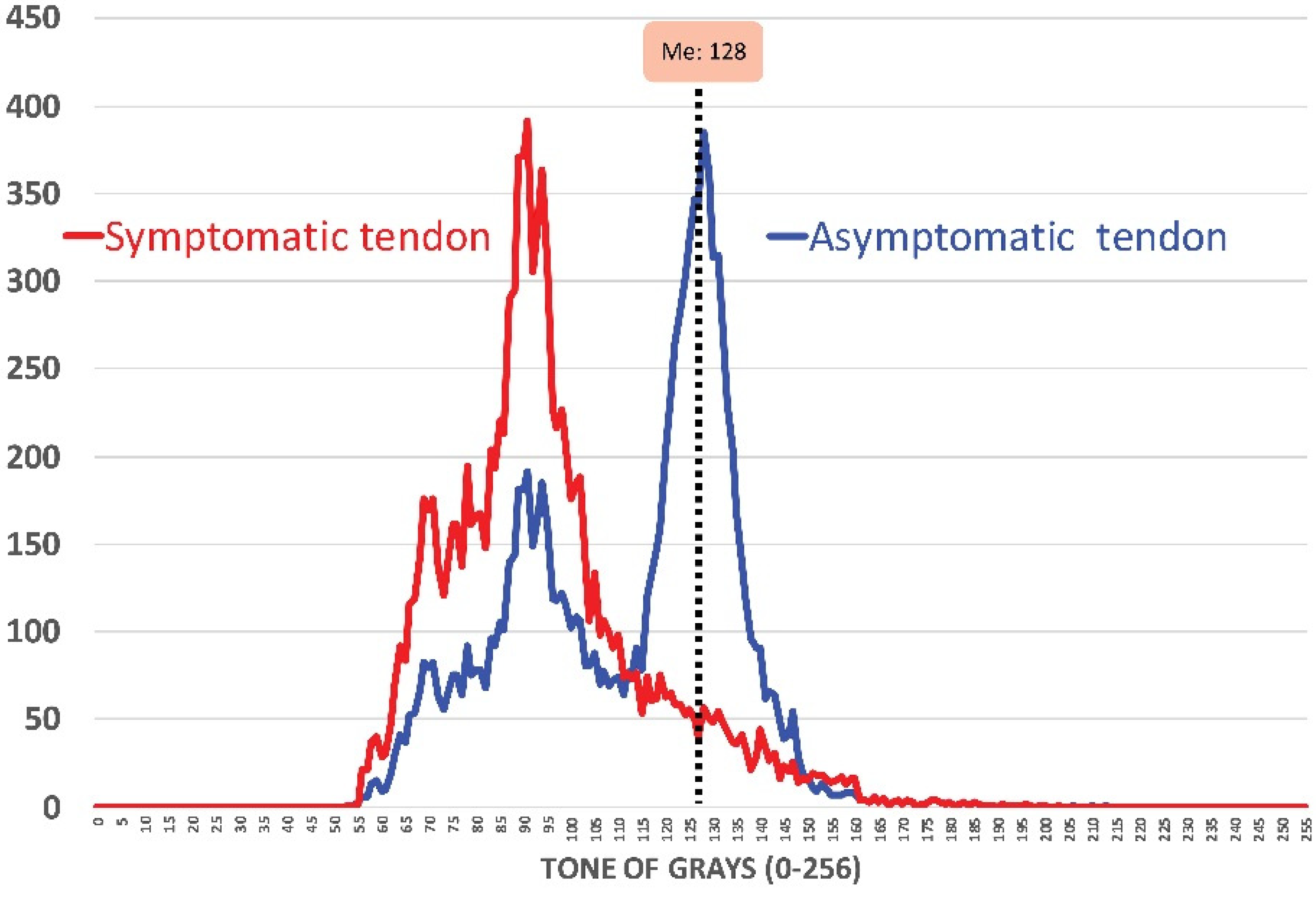
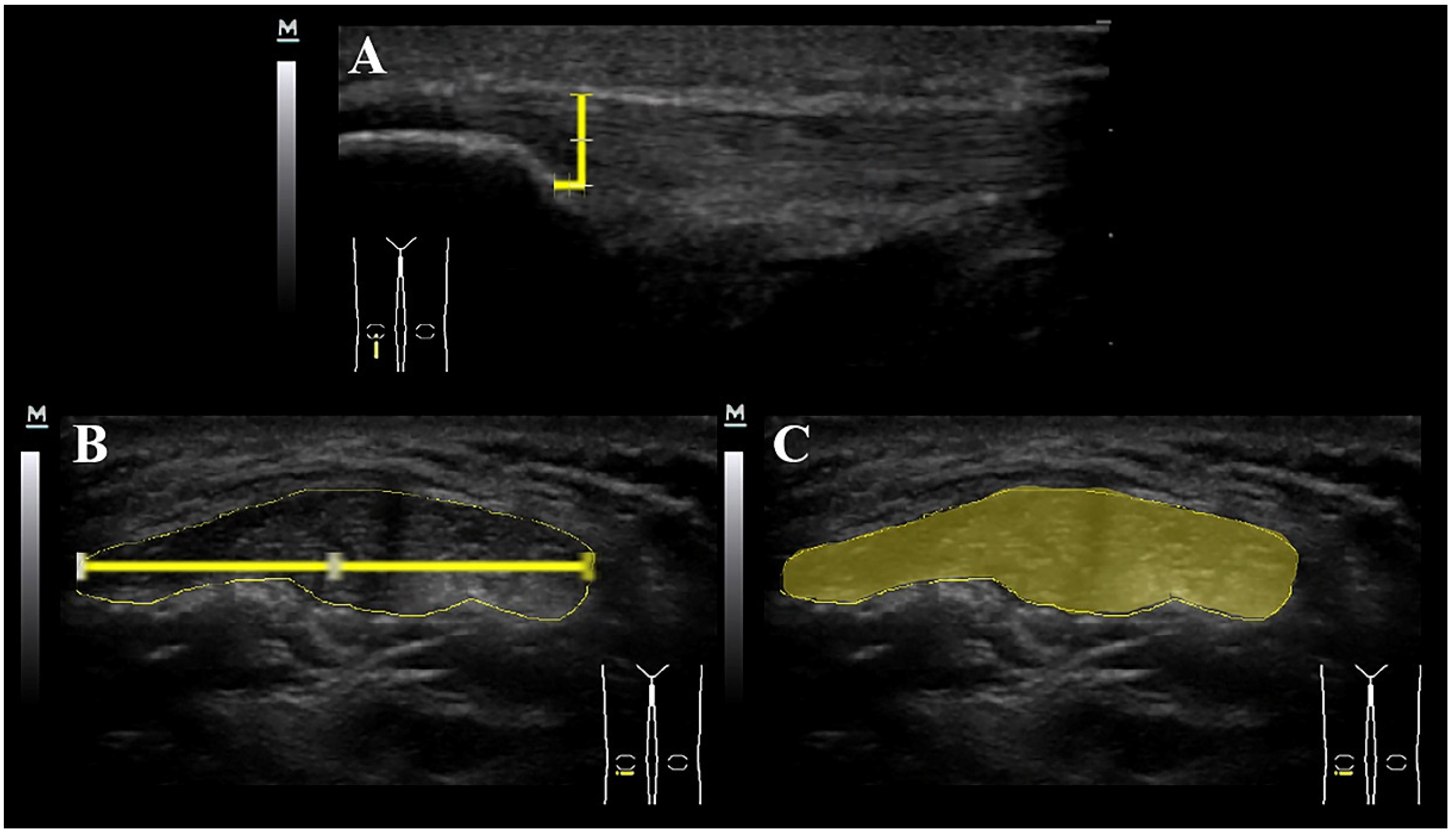
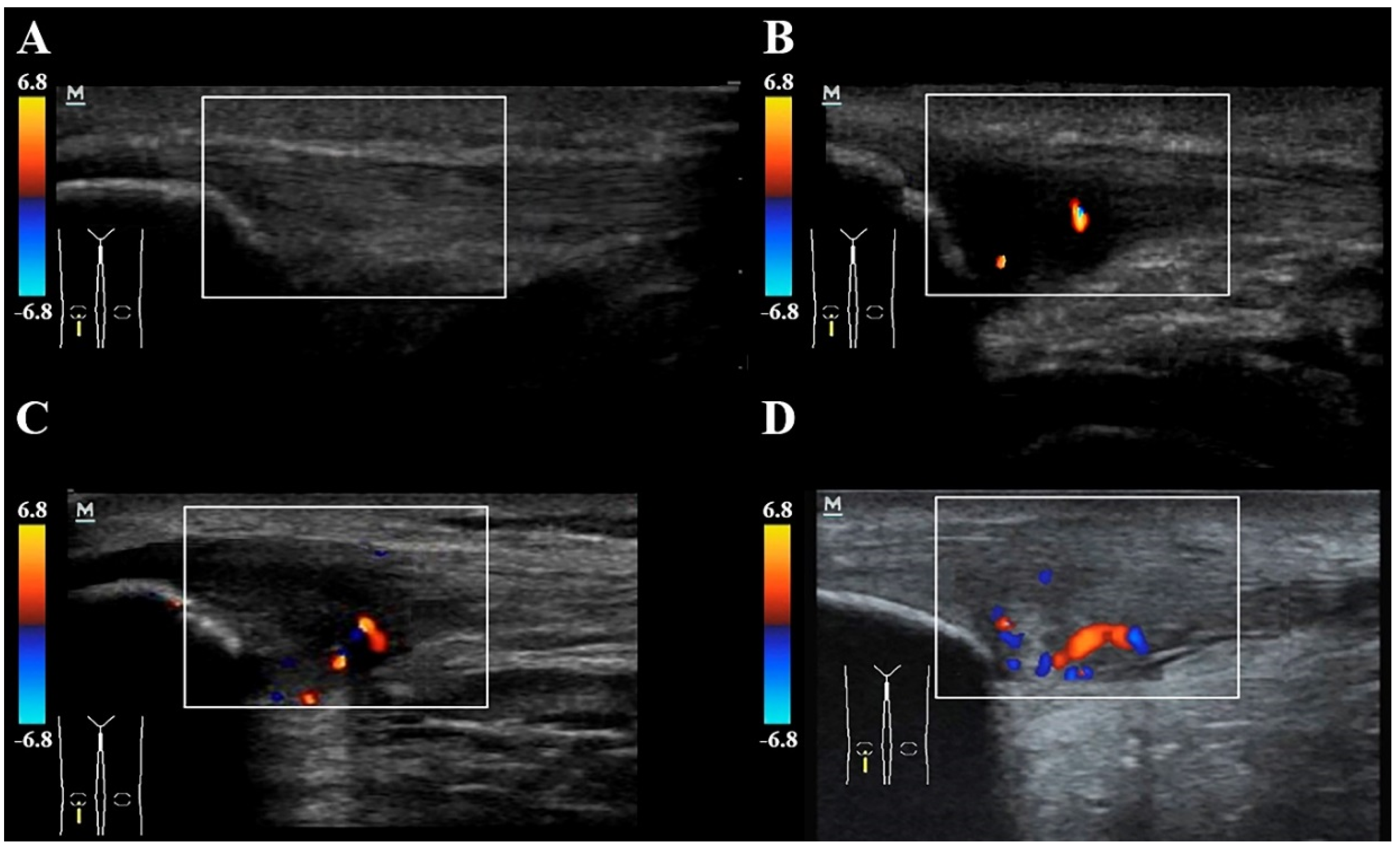
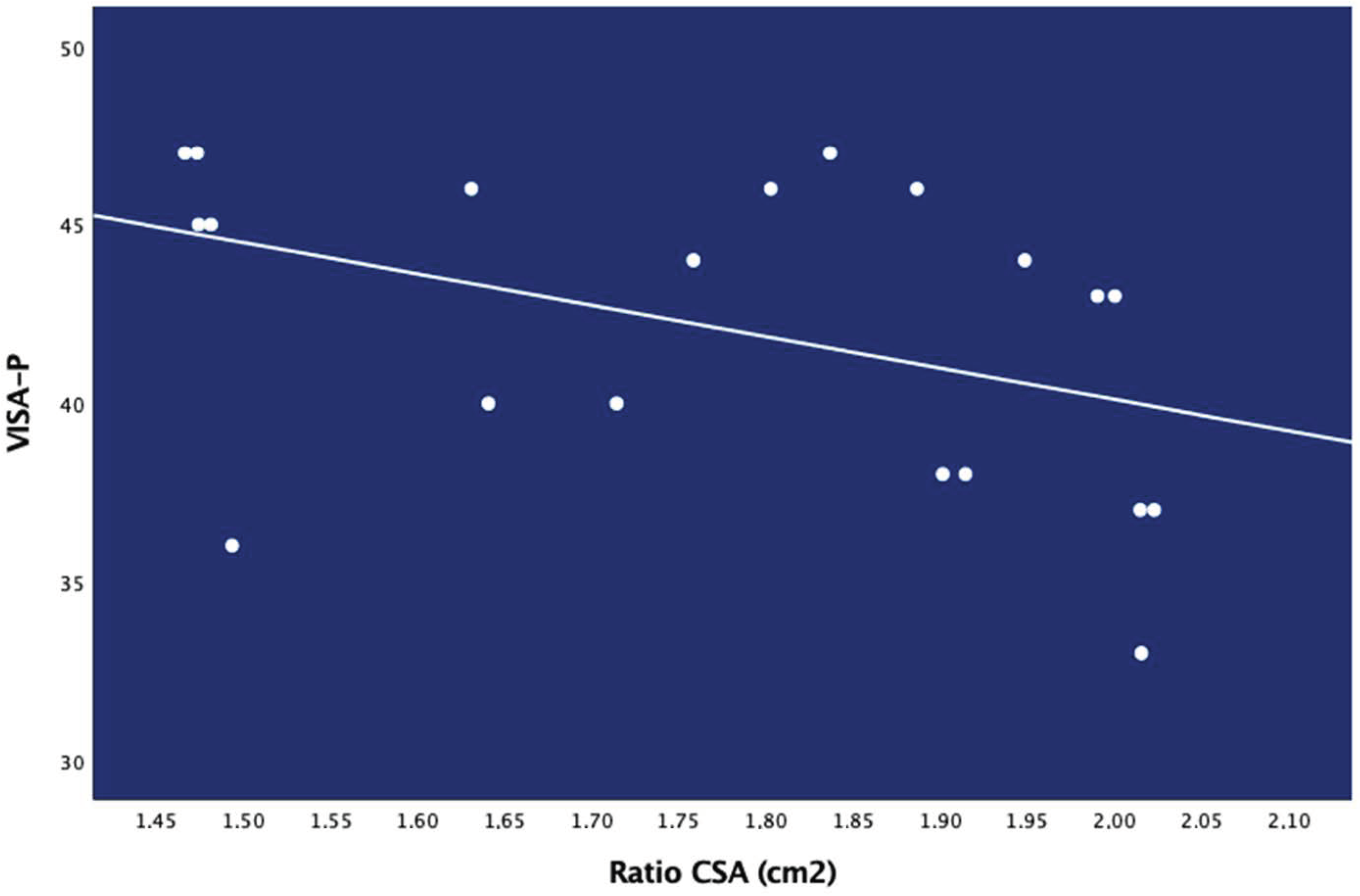
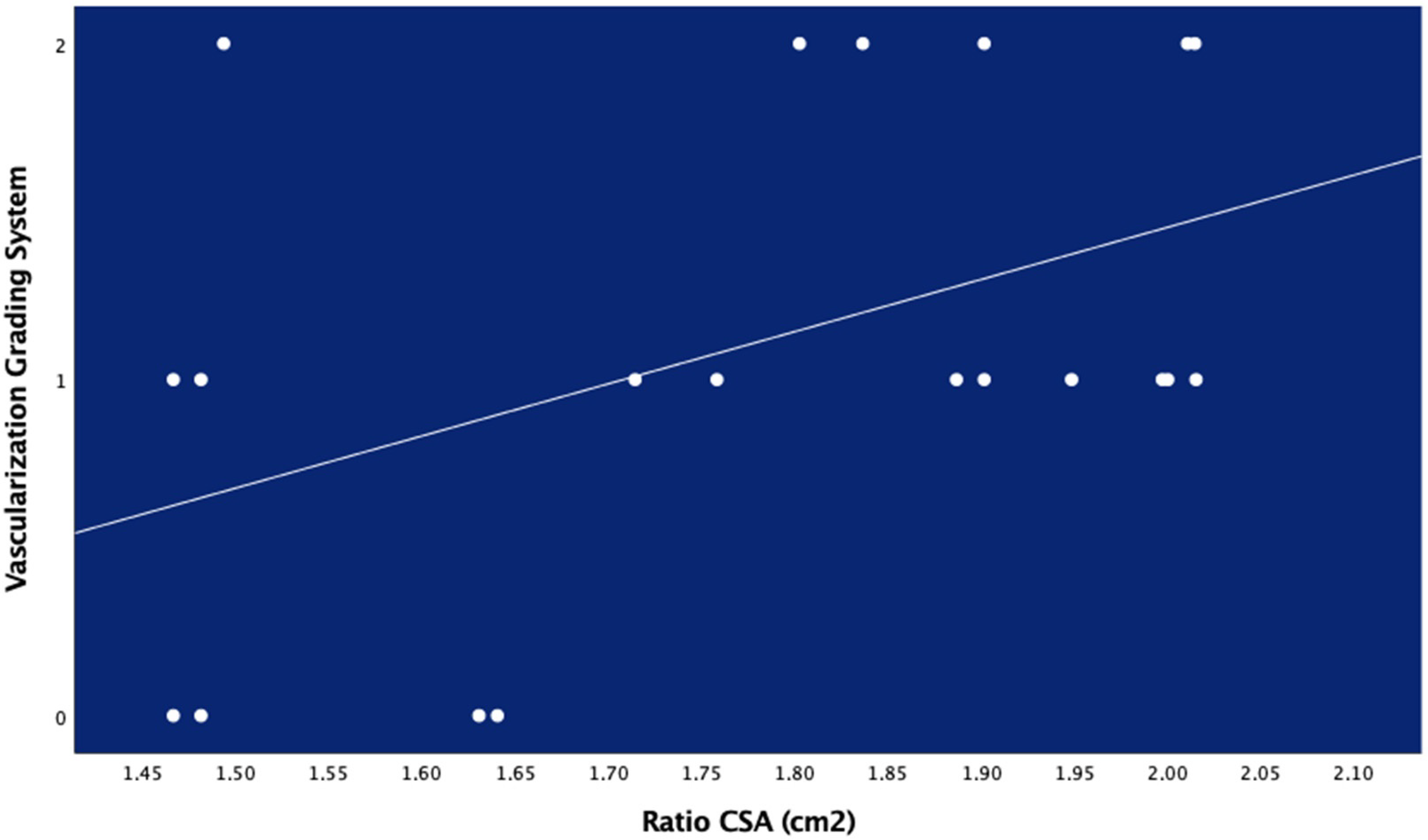
| Clinical Features | Controls | Patients | p-Value |
|---|---|---|---|
| Age (years) | 42.5 (5.5) | 45.0 (4.5) | 1.00 |
| Weight (kg) | 73.00 (8.1) | 77.2 (9.6) | 0.142 |
| Height (cm) | 176.5 (6.5) | 169.8 (4.8) | 0.001 |
| BMI (kg/m2) | 23.4 (2.0) | 26.8 (3.2) | <0.001 |
| NPRS (0–10 points) | - | 5.2 (1.2) | |
| Time with pain (months) | - | 4.9 (5.3) | |
| VISA-P (0–100 points) | - | 42.1 (4.3) | |
| Medication (NSAIDs, n; %) | - | 5 (25%) | |
| Ultrasound features | |||
| Hypoechoic Area (n; %) | 0; 0% | 20; 100% | |
| Neovascularization (n; %) | 0; 0% | 14; 70% | |
| Vascularization grading system Grade 0 Grade I Grade II Grade III Grade IV | 20; 100% - - - - | 6; 30% 10; 50% 4; 20% - - | |
| Ultrasound Measure | Time with Pain | NPRS | VISA-P |
|---|---|---|---|
| Thickness | −0.006 (−0.447 to 0.437, p = 0.980) | −0.103 (−0.521 to 0.355, p = 0.666) | −0.145 (−0.552 to 0.317, p = 0.543) |
| Width | 0.074 (−0.380 to 0.500, p = 0.758) | 0.026 (−0.421 to 0.463, p = 0.914) | 0.009 (−0.435 to 0.449, p = 0.970) |
| CSA | −0.338 (−0.678 to 0.122, p = 0.145) | 0.132 (−0.329 to 0.542, p = 0.580) | 0.038 (−0.411 to 0.472, p = 0.873) |
| Ultrasound Measures | Controls (Mean Value) | Patients with Patellar Tendinopathy | Mean Difference (95% CI); Cohen’s d (a) Asymptomatic Knee vs. Healthy (b) Symptomatic Knee vs. Healthy (c) Symptomatic vs. Asymptomatic | |
|---|---|---|---|---|
| Asymptomatic Knee | Symptomatic Knee | |||
| Thickness (cm) | 1.01 (0.11) | 1.55 (0.19) | 3.22 (0.35) | (a) 0.54 (0.44 to 0.64); d = 3.48 † (b) 2.21 (2.04 to 2.38); d = 8.52 † (c) 1.67 (1.50 to 1.84); d = 4.68 † |
| Width (cm) | 2.23 (0.44) | 3.20 (0.40) | 5.82 (0.45) | (a) 0.97 (0.70 to 1.24); d = 2.31 † (b) 3.59 (3.30 to 3.87); d = 8.07 † (c) 2.62 (2.42 to 2.81); d = 6.32 † |
| CSA (cm2) | 2.07 (0.21) | 3.08 (0.26) | 5.43 (0.52) | (a) 1.01 (0.86 to 1.16); d = 4.27 † (b) 3.36 (3.10 to 3.61); d = 8.47 † (c) 2.35 (2.06 to 2.63); d = 3.85 † |
| Stastistics | Ratios | ||
|---|---|---|---|
| Thickness | Width | CSA | |
| ROC value (95% CI) | 0.977 (0.941 to 1.000) | 0.993 (0.974 to 1.000) | 0.960 (0.907 to 1.000) |
| Youden Index | 0.85 | 0.95 | 0.85 |
| Cut-off Ratio Point | 1.60 | 1.47 | 1.41 |
| Sensitivity | 95% | 95% | 100% |
| Specificity | 90% | 100% | 85% |
| PPV | 91% | 100% | 87% |
| NPV | 95% | 95% | 100% |
| Positive LR | 9.5 | >95 | 6.7 |
| Negative LR | 0.06 | 0.05 | 0.00 |
| Ultrasound Measure | Time with Pain | NPRS | VISA-P |
|---|---|---|---|
| Thickness Ratio | −0.149 (−0.554 to 0.314, p = 0.529) | −0.149 (−0.554 to 0.314, p = 0.529) | −0.184 (−0.579 to 0.281, p = 0.437) |
| Width Ratio | 0.037 (−0.412 to 0.471, p = 0.878) | 0.037 (−0.412 to 0.471, p = 0.878) | 0.033 (−0.415 to 0.468, p = 0.892) |
| CSA Ratio | 0.353 (−0.106 to 0.688, p = 0.126) | 0.353 (−0.106 to 0.688, p = 0.126) | −0.581 (−0.815 to −0.195, p = 0.007) * |
| Vascularization Grading System Median (1st and 3rd Quartile); Mean (SD) | Mann–Whitney U Test p-Value | ||
|---|---|---|---|
| Grade 0 (n = 6) | Grade I and II (n = 14) | ||
| Clinical Outcomes | |||
| NPRS (0–10) | 4.5 (4.0–5.75);4.75 (1.0) | 5.5 (4.0–6.0);5.31 (1.25) | p = 0.380 |
| Time with pain (months) | 9.5 (7.25–10.75);9.2 (2.6) | 9.00 (8.0–11.75); 10.1 (2.8) | p = 0.737 |
| VISA-P (0–100 points) | 45.5 (41.25–46.75); 44.5 (3.1) | 43.00 (37.25–45.75); 41.5 (4.5) | p = 0.184 |
| Ultrasound Measures | |||
| Thickness (cm) | 3.25 (2.65–3.66); 3.2 (0.55) | 3.15 (2.95–3.5); 3.2 (0.3) | p = 0.850 |
| Width (cm) | 5.8 (5.5–6.1); 5.7 (0.45) | 5.9 (5.6–6.1); 5.85 (0.45) | p = 0.836 |
| CSA (cm2) | 5.0 (4.8–5.7); 5.15 (0.5) | 5.55 (5.0–6.0.); 5.5 (0.5) | p = 0.276 |
| Ratio Thickness (cm) | 2.3 (2.05–2.7); 2.3 (0.4) | 2.0 (1.8–2.4); 2.0 (0.35) | p = 0.148 |
| Ratio Width (cm) | 1.8 (1.6–2.0); 1.8 (0.2) | 1.9 (1.6–2.2); 1.9 (0.3) | p = 0.591 |
| Ratio CSA (cm2) | 1.55 (1.5–1.65); 1.55 (0.1) | 1.9 (1.7–2.0); 1.85 (0.2) | p = 0.017 * |
| Ultrasound Measure | Thickness | Width | CSA |
|---|---|---|---|
| Ohberg score | 0.089 (−0.368 to 0.511, p = 0.710) | 0.056 (−0.396 to 0.486, p = 0.815) | 0.172 (−0.292 to 0.571, p = 0.469) |
| Ultrasound measure | Thickness Ratio | Width Ratio | CSA Ratio |
| Ohberg score | 0.253 (−0.213 to 0.625, p = 0.282) | 0.154 (−0.309 to 0.558, p = 0.516) | 0.453 (0.014 to 0.745, p = 0.015) * |
Publisher’s Note: MDPI stays neutral with regard to jurisdictional claims in published maps and institutional affiliations. |
© 2020 by the authors. Licensee MDPI, Basel, Switzerland. This article is an open access article distributed under the terms and conditions of the Creative Commons Attribution (CC BY) license (http://creativecommons.org/licenses/by/4.0/).
Share and Cite
Arias-Buría, J.L.; Fernández-de-las-Peñas, C.; Rodríguez-Jiménez, J.; Plaza-Manzano, G.; Cleland, J.A.; Gallego-Sendarrubias, G.M.; López-de-Uralde-Villanueva, I. Ultrasound Characterization of Patellar Tendon in Non-Elite Sport Players with Painful Patellar Tendinopathy: Absolute Values or Relative Ratios? A Pilot Study. Diagnostics 2020, 10, 882. https://doi.org/10.3390/diagnostics10110882
Arias-Buría JL, Fernández-de-las-Peñas C, Rodríguez-Jiménez J, Plaza-Manzano G, Cleland JA, Gallego-Sendarrubias GM, López-de-Uralde-Villanueva I. Ultrasound Characterization of Patellar Tendon in Non-Elite Sport Players with Painful Patellar Tendinopathy: Absolute Values or Relative Ratios? A Pilot Study. Diagnostics. 2020; 10(11):882. https://doi.org/10.3390/diagnostics10110882
Chicago/Turabian StyleArias-Buría, José L., César Fernández-de-las-Peñas, Jorge Rodríguez-Jiménez, Gustavo Plaza-Manzano, Joshua A. Cleland, Gracia M. Gallego-Sendarrubias, and Ibai López-de-Uralde-Villanueva. 2020. "Ultrasound Characterization of Patellar Tendon in Non-Elite Sport Players with Painful Patellar Tendinopathy: Absolute Values or Relative Ratios? A Pilot Study" Diagnostics 10, no. 11: 882. https://doi.org/10.3390/diagnostics10110882
APA StyleArias-Buría, J. L., Fernández-de-las-Peñas, C., Rodríguez-Jiménez, J., Plaza-Manzano, G., Cleland, J. A., Gallego-Sendarrubias, G. M., & López-de-Uralde-Villanueva, I. (2020). Ultrasound Characterization of Patellar Tendon in Non-Elite Sport Players with Painful Patellar Tendinopathy: Absolute Values or Relative Ratios? A Pilot Study. Diagnostics, 10(11), 882. https://doi.org/10.3390/diagnostics10110882






